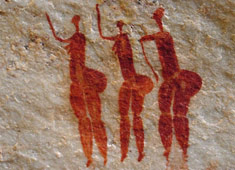ORIGINS Centre

One example of the rock art in the Wits University collection, which is probably the largest in the world (Image: Origins Centre)
From the City of Johannesburg comes this exciting news for archaeology and anthropology fans like me: Origins Centre traces history of mankind, written by Ndaba Dlamini.
My summary: On March 7th, 2006 President Thabo Mbeki officially opened the University of the Witwatersrand's Origins Centre, the world's only museum dedicated to exploring and celebrating the history of modern humankind. The first phase of the museum showcases the origins of humankind as well as an extensive collection of rock art from the Wits Art Research Institute. Many of the diverse exhibits bring to life the heritage of the San, whose DNA contains the earliest genetic print, linking this hunter-gatherer to the Homo sapiens who lived 160,000 years ago. For the first time in South Africa, archaeology had been brought to people to appreciate and no longer would people regard rock art as "crude", Mbeki said.
Very unique is that the Origins Centre is inviting South Africans and international tourists to have their DNA tested to determine their ancestry - and have the results exhibited alongside those of Nelson Mandela. Read more about it in Are you related to Mandela? Fascinating!
If I was traveling to South Africa, the Origins Centre would be on top of the list of places to visit. Their website appears to be still under development, but there is more at South Africa Info including great links including the fabulous Rock Art Gallery.
More related links and images:
my earlier page on South African rock art
Marja-Leena | 04/04/2006 | 4 comments
themes: Anthropology, Rock Art & Archaeology

Marja-leena: Thanks for the links on rock art! I perused a couple of them yesterday. I'm reading Alexander McCall Smith right now - one of his Ladie's No. 1 Detective Agency series, which is set in Botswana. It's fascinating for me to read about the culture of the people there - even though the novel is set in modern times.
What I really find interesting is the similarities in the rock art of Africa, and that of the rock art around my home island, Kodiak. I'll try to find a good link to send you. We have several great petroglyph spots that have survived the weather on Kodiak. There are also pocket-sized examples of Kodiak petroglyphs in the museums. My native corporation has taken a petroglyph of an orca for its logo.
Jackie, I agree about the similarities! I haven't seen any Kodiak petroglyphs and would love to see them, but I'm often amazed at how similar works can appear from many areas of the world.
Oh, it just occurrred to me as I'm writing this - duh! These African works are pictographs, I think, since they are painted on. Petroglyphs are carved or engraved images. You say the Kodiak ones are petroglyphs? Pictographs tend to not survive the elements as long.
Marja-leena: yes - the Kodiak ones are petroglyphs - carved into the rock. There is a small book or pamphlet that's been published on them, and different ones appear in many books about the indigenous culture. They also used small petroglyphs to adorn their stone oil lamps and other tools. My dad found a beautiful, unique stone lamp on the beach many years ago. It is somewhat triangular, large - weighs 3-5 lbs, and has a face on each side, as well as on the bottom. It appears to be some sort of granite or schist, so it survived rolling around in the surf better than the usual slate or sandstone variety. He donated the piece to the musuem,when it opened with funds from the Exxon Valdez oil spill and several native corporations.
Thanks Jackie for this fascinating information. I wish I could see those books and that lamp. Will have to do some googling- more and more of this information is appearing online to my delight, as I don't travel that much.